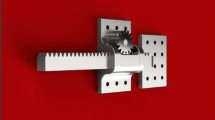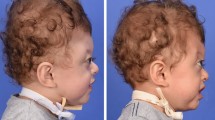Abstract
Purpose
The treatment of patients with multisuture craniosynostosis is complex and patient-dependent. Cranial distraction osteogenesis is a relatively new procedure for treatment of these patients, with its use increasing in many centers. With this increased use comes an expanding range of indications. Surgical management of multisuture craniosynostosis in therapeutically immunosuppressed patients following a solid organ transplant presents unique challenges. We describe our experience with posterior cranial vault distraction in two patients with multisuture craniosynostosis that had previously undergone organ transplantation.
Methods
Two solid-organ transplant recipient patients with multisuture craniosynostosis were identified. A detailed examination of their medical/transplant history and perioperative details were recorded.
Results
The first patient was a 3-year-old girl who received a kidney transplantation in infancy and subsequently presented with a symptomatic Chiari malformation and papilledema. Imaging revealed pansynostosis. She underwent posterior cranial vault distraction extending into a Chiari decompression. Her postoperative course was complicated by distractor site infection at the beginning of consolidation, necessitating early removal of distractors. The second patient was a 2-year-old boy who received a heart transplantation at the age of 3 months and subsequently presented with head shape concerns. Imaging revealed bicoronal and sagittal craniosynostosis. He underwent a posterior cranial vault distraction without complication. Following removal of the distractors, he developed an infection at one of the distractor sites with associated fever and leukocytosis, necessitating washout and drain placement. Both patients achieved successful cranial vault expansion with distraction osteogenesis and at a 2-year follow-up do not have evidence of elevated intracranial pressure.
Conclusions
Immunosuppressive therapy has the potential to inhibit wound healing and place patients at risk for wound infection. Although we have demonstrated successful cranial vault expansion with distraction in two immunosuppressed children, extra care must be taken with these patients when placing semi-buried hardware. Specifically, prompt identification and proactive management of potential infectious complications is critical to applying this technique safely in these patients.






Similar content being viewed by others
Data availability
Not applicable
Code availability
Not applicable
References
Renier D, Sainte-Rose C, Marchac D, Hirsch JF (1982) Intracranial pressure in craniostenosis. J Neurosurg 57:370–377. https://doi.org/10.3171/jns.1982.57.3.0370
Kapp-Simon KA, Speltz ML, Cunningham ML, Patel PK, Tomita T (2007) Neurodevelopment of children with single suture craniosynostosis: a review. Childs Nerv Syst 23:269–281
Derderian CA, Wink JD, McGrath JL et al (2015) Volumetric changes in cranial vault expansion: comparison of fronto-orbital advancement and posterior cranial vault distraction osteogenesis. Plast Reconstr Surg 135:1665–1672. https://doi.org/10.1097/PRS.0000000000001294
Lin LO, Zhang RS, Hoppe IC, Paliga JT, Swanson JW, Bartlett SP, Taylor JA (2019) Onset and resolution of Chiari malformations and hydrocephalus in syndromic craniosynostosis following posterior vault distraction. Plast Reconstr Surg 144:932–940. https://doi.org/10.1097/PRS.0000000000006041
Li J, Gerety PA, Xu W, Bartlett SP, Taylor JA (2016) A perioperative risk comparison of posterior vault distraction osteogenesis in an older pediatric population. J Craniofac Surg 27:1165–1169. https://doi.org/10.1097/SCS.0000000000002795
Palamuthusingam D, Kunarajah K, Pascoe EM, Johnson DW, Hawley CM, Fahim M (2020) Postoperative outcomes of kidney transplant recipients undergoing non-transplant-related elective surgery: a systematic review and meta-analysis. BMC Nephrol 21:21. https://doi.org/10.1186/s12882-020-01978-4
Vandegrift MT, Nahai F (2016) Is aesthetic surgery safe in the solid organ transplant patient? An international survey and review. Aesthet Surg J 36
Polcz ME, Barbul A (2019) The role of vitamin A in wound healing. Nutr Clin Pract 34:695–700
White N, Evans M, Dover S et al (2009) Posterior calvarial vault expansion using distraction osteogenesis. Childs Nerv Syst 25:231–236. https://doi.org/10.1007/s00381-008-0758-6
Taylor JA, Bartlett SP (2017) What’s new in syndromic craniosynostosis surgery? Plast Reconstr Surg 140:82e–93e. https://doi.org/10.1097/PRS.0000000000003524
Zhang RS, Wes AM, Naran S, Hoppe IC, Sun J, Mazzaferro D, Bartlett SP, Taylor JA (2018) Posterior vault distraction osteogenesis in nonsyndromic patients: an evaluation of indications and safety. J Craniofac Surg 29:566–571. https://doi.org/10.1097/SCS.0000000000004230
Derderian CA, Bartlett SP (2012) Open cranial vault remodeling. J Craniofac Surg 23:229–234. https://doi.org/10.1097/scs.0b013e318241b93a
Nowinski D, di Rocco F, Renier D, SainteRose C, Leikola J, Arnaud E (2012) Posterior cranial vault expansion in the treatment of craniosynostosis. Comparison of current techniques. Child’s Nervous System 28:1537–1544. https://doi.org/10.1007/s00381-012-1809-6
Choi M, Flores RL, Havlik RJ (2012) Volumetric analysis of anterior versus posterior cranial vault expansion in patients with syndromic craniosynostosis. J Craniofac Surg 23:455–458
Goldstein JA, Paliga JT, Wink JD, Low DW, Bartlett SP, Taylor JA (2013) A craniometric analysis of posterior cranial vault distraction osteogenesis. Plast Reconstr Surg 131:1367–1375. https://doi.org/10.1097/PRS.0b013e31828bd541
Serlo WS, Ylikontiola LP, Lähdesluoma N, Lappalainen OP, Korpi J, Verkasalo J, Sàndor GKB (2011) Posterior cranial vault distraction osteogenesis in craniosynostosis: estimated increases in intracranial volume. Childs Nerv Syst 27:27–633. https://doi.org/10.1007/s00381-010-1353-1
ter Maaten NS, Mazzaferro DM, Wes AM, Naran S, Bartlett SP, Taylor JA (2018) Craniometric Analysis of frontal cranial morphology following posterior vault distraction. J Craniofac Surg 29:1169–1173. https://doi.org/10.1097/SCS.0000000000004473
Mazzaferro DM, ter Maaten NS, Wes AM, Naran S, Bartlett SP, Taylor JA (2019) A craniometric analysis of the posterior cranial base after posterior vault distraction. J Craniofac Surg 30:1692–1695. https://doi.org/10.1097/SCS.0000000000005496
Shimizu A, Komuro Y, Shimoji K, Miyajima M, Arai H (2016) Quantitative analysis of change in intracranial volume after posterior cranial vault distraction. J Craniofac Surg 27:1135–1138. https://doi.org/10.1097/SCS.0000000000002739
Salokorpi N, Vuollo V, Sinikumpu JJ, Satanin L, Nestal Zibo H, Ylikontiola LP, Pirttiniemi P, Sándor GK, Serlo W (2017) Increases in cranial volume with posterior cranial vault distraction in 31 consecutive cases. Neurosurgery 81:803–811. https://doi.org/10.1093/neuros/nyx125
Bauder AR, Wink JD, Swanson JW, Derderian C, Bartlett SP, Taylor JA (2015) An analysis of posterior vault distraction and its effects on the posterior fossa and cranial base. Plast Reconstr Surg 136:52–53. https://doi.org/10.1097/01.prs.0000472342.36900.c7
Greives MR, Ware BW, Tian AG, Taylor JA, Pollack IF, Losee JE (2016) Complications in posterior cranial vault distraction. Ann Plast Surg 76:211–215. https://doi.org/10.1097/SAP.0000000000000518
Author information
Authors and Affiliations
Contributions
All authors contributed to the design, data collection, and manuscript preparation.
Corresponding author
Ethics declarations
Ethics approval
Deemed “exempt” from the Institutional Review Board of the University of Mississippi Medical Center.
Consent to participate
Not applicable; the study was retrospective.
Consent for publication
All patients provided written consent for use of pictures in publications.
Conflict of interest
No authors report any conflicts of interest.
Additional information
Publisher’s note
Springer Nature remains neutral with regard to jurisdictional claims in published maps and institutional affiliations.
Rights and permissions
About this article
Cite this article
Sullivan, J.S., Snider, A.E., Farrington, J. et al. Posterior cranial vault distraction osteogenesis in the immunocompromised patient. Childs Nerv Syst 37, 2313–2318 (2021). https://doi.org/10.1007/s00381-021-05202-y
Received:
Accepted:
Published:
Issue Date:
DOI: https://doi.org/10.1007/s00381-021-05202-y




